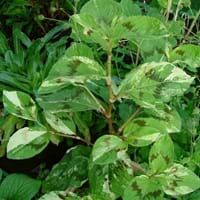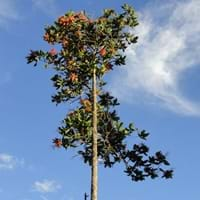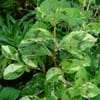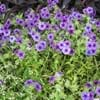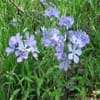Life Span
Perennial
Annual
Type
Herbaceous Perennial
Tree
Origin
North America, United States, Northeastern United States, Mid-Atlantic United States, Southeastern United States, Central United States, South-Central United States, Canada, Eastern Asia, India, Nepal, China, Japan, Korea
Caribbean, Central America, South America, Brazil
Types
Not Available
Not Available
Habitat
Cliffs, Moist woods, Riverbanks
Subtropical climates, subtropical regions
USDA Hardiness Zone
5-9
10-15
Sunset Zone
2a, 2b, 3a, 3b, 4, 5, 6, 7, 8, 9, 14, 15, 16, 17
H1, H2
Habit
Upright/Erect
Upright/Erect
Flower Color
Light Green
Ivory, Gray
Flower Color Modifier
Bicolor
Bicolor
Fruit Color
Dark Red, Copper
Magenta, Violet
Leaf Color in Spring
Green, Dark Green
Green
Leaf Color in Summer
Green, Dark Green
Green
Leaf Color in Fall
Dark Green, Dark Red
Green
Leaf Color in Winter
Not Available
Green
Leaf Shape
Elliptic
Cuneate
Plant Season
Summer, Fall
Spring, Winter
Sunlight
Full Sun, Partial Sun
Full Sun, Partial Sun
Type of Soil
Clay, Loam, Sand
Loam
The pH of Soil
Acidic, Neutral
Acidic, Neutral
Soil Drainage
Average
Average
Bloom Time
Late Summer, Early Fall
Early Spring, Spring, Late Spring, Late Winter
Tolerances
Drought
Wet Site, Drought
Where to Plant?
Ground
Ground
How to Plant?
From Rhizomes, Seedlings
Seedlings
Plant Maintenance
Medium
Medium
Watering Requirements
Keep ground moist
Does not require regular watering
In Summer
Lots of watering
Lots of watering
In Spring
Moderate
Moderate
In Winter
Average Water
Average Water
Soil pH
Acidic, Neutral
Acidic, Neutral
Soil Type
Clay, Loam, Sand
Loam
Soil Drainage Capacity
Average
Average
Sun Exposure
Full Sun, Partial Sun
Full Sun, Partial Sun
Pruning
In late autumn, Remove damaged leaves, Remove dead leaves
Remove damaged leaves, Remove dead branches, Remove dead leaves
Fertilizers
All-Purpose Liquid Fertilizer
All-Purpose Liquid Fertilizer
Pests and Diseases
Red blotch
Red blotch
Plant Tolerance
Drought
Drought
Flowers
Showy
Insignificant
Flower Petal Number
Not Available
Single
Foliage Texture
Medium
Coarse
Foliage Sheen
Not Available
Glossy
Invasive
Sometimes
Sometimes
Attracts
Not Available
Not Available
Allergy
Not Available
Asthma
Aesthetic Uses
Not Used For Aesthetic Purpose
Not Available
Beauty Benefits
Not Available
Not Available
Edible Uses
Not Available
No
Environmental Uses
Air purification
Air purification
Medicinal Uses
Not Available
Not Available
Part of Plant Used
Not Available
Wood
Other Uses
Decorative veneers, flooring, paneling, Showy Purposes
Used for woodware, Wood is used for making furniture
Used As Indoor Plant
No
No
Used As Outdoor Plant
Yes
Yes
Garden Design
Wildflower
Feature Plant, Shade Trees, Street Trees, Tropical
Botanical Name
PERSICARIA virginiana
TRIPLARIS americana
Common Name
Jumpseed
Ant Stick, Macaw, St. Mary's Stick
In Spanish
jumpseed
guacamayo
In Portuguese
jumpseed
arara
In Latin
Salire celeritate
Ara
Phylum
Tracheophyta
Tracheophyta
Class
Magnoliopsida
Magnoliopsida
Order
Caryophyllales
Caryophyllales
Family
Polygonaceae
Polygonaceae
Genus
Periscaria
Triplaris
Clade
Angiosperms, Core eudicots, Eudicots
Angiosperms, Core eudicots, Eudicots
Tribe
Not Available
Not Available
Subfamily
Not Available
Not Available
Number of Species
Not Available
Not Available
Difference Between Jumpseed and Macaw
If you are confused whether Jumpseed or Macaw are same, here are some features about those plants to help you choose better. Many people think that these two plants have the same characteristics, but one can see Jumpseed and Macaw Information and learn more about it. Fertilizers required for proper growth of Jumpseed are All-Purpose Liquid Fertilizer, whereas for Macaw fertilizers required are All-Purpose Liquid Fertilizer. Hence, one should know the basic difference between Jumpseed and Macaw if you are planning to have them in your garden to enhance its beauty.
<
Flowering PlantsImportance of Jumpseed and Macaw
Want to have the most appropriate plant for your garden? You might want to know the importance of Jumpseed and Macaw. Basically, these two plants vary in many aspects. Compare Jumpseed and Macaw as they differ in many characteristics such as their life, care, benefits, facts, etc. Every gardener must at least have the slightest clue about the plants he wants to plant in his garden. Compare their benefits, which differ in many ways like facts and uses. The medicinal use of Jumpseed is Not Available whereas of Macaw is Not Available. Jumpseed has beauty benefits as follows: Not Available while Macaw has beauty benefits as follows: Not Available.
Compare Facts of Jumpseed vs Macaw
How to choose the best garden plant for your garden depending upon its facts? Here garden plant comparison will help you to solve this query. Compare the facts of Jumpseed vs Macaw and know which one to choose. As garden plants have benefits and other uses, allergy is also a major drawback of plants for some people. Allergic reactions of Jumpseed are Not Available whereas of Macaw have Asthma respectively. Having a fruit bearing plant in your garden can be a plus point of your garden. Jumpseed has no showy fruits and Macaw has showy fruits. Also Jumpseed is not flowering and Macaw is not flowering . You can compare Jumpseed and Macaw facts and facts of other plants too.
